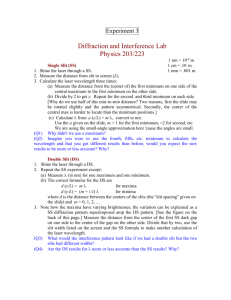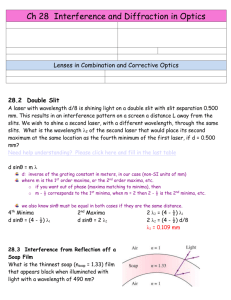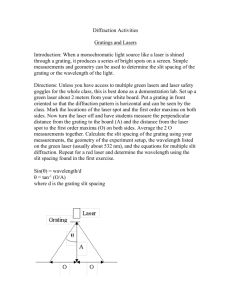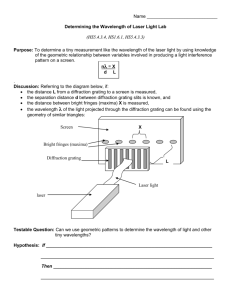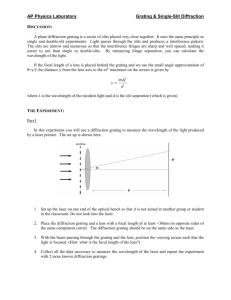LAB C9: THE DIFFRACTION GRATING
advertisement
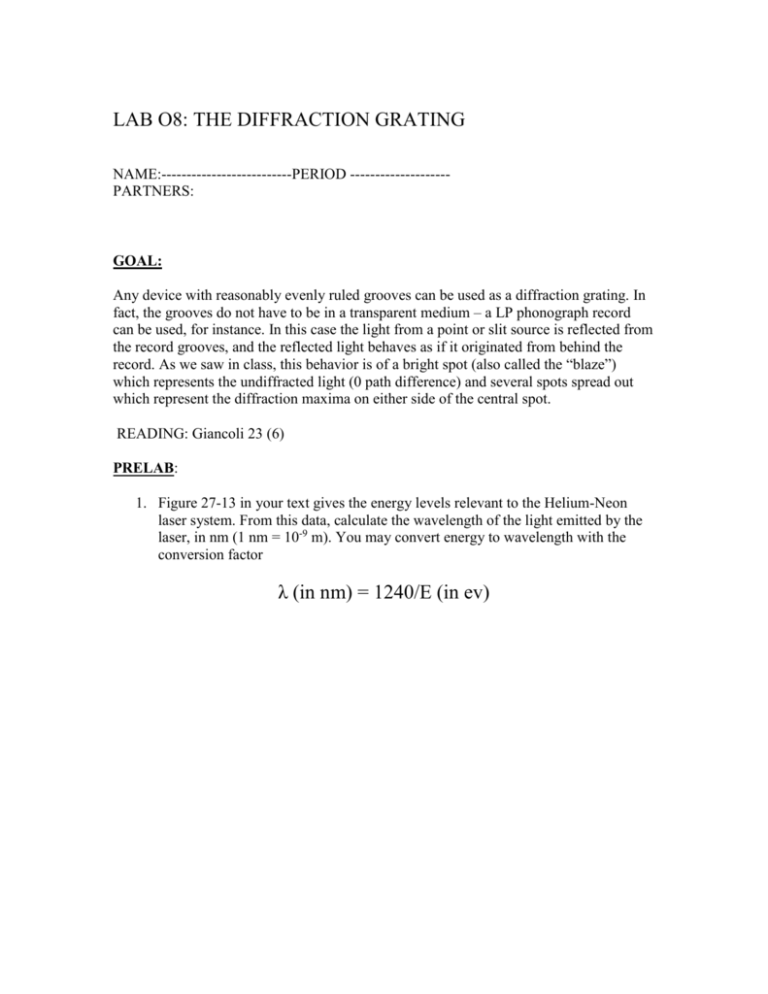
LAB O8: THE DIFFRACTION GRATING NAME:--------------------------PERIOD -------------------PARTNERS: GOAL: Any device with reasonably evenly ruled grooves can be used as a diffraction grating. In fact, the grooves do not have to be in a transparent medium – a LP phonograph record can be used, for instance. In this case the light from a point or slit source is reflected from the record grooves, and the reflected light behaves as if it originated from behind the record. As we saw in class, this behavior is of a bright spot (also called the “blaze”) which represents the undiffracted light (0 path difference) and several spots spread out which represent the diffraction maxima on either side of the central spot. READING: Giancoli 23 (6) PRELAB: 1. Figure 27-13 in your text gives the energy levels relevant to the Helium-Neon laser system. From this data, calculate the wavelength of the light emitted by the laser, in nm (1 nm = 10-9 m). You may convert energy to wavelength with the conversion factor λ (in nm) = 1240/E (in ev) 2. Measure the groove spacing in a 33 1/3 rpm record by timing the travel of the phonograph needle from the beginning to the end of a relatively quiet track (because the grooves are a little closer together and more uniform) on the record. Using the measured radial width of the track and the known frequency of the turntable, find the number of the grooves and hence the groove spacing. This spacing should turn out to be on the order of 0.1 nm (100,000nm, or about 160 times the wavelength of the laser light). 3. From the condition for constructive interference between two waves, derive the grating equation: n λ = d sin θ where n is the number of wavelengths path difference, d is the spacing between adjacent grooves in the grating, λ is the wavelength of the light and θ is the angle the diffracted waves make with the undeflected waves. ************** Have instructor initial before proceeding further _____________ LAB PROCEDURE: 1. Place a laser on a flat surface and put the slit film in front of it so that it shines through the grating frame in the very center of the plate. With the system set about 2 m from the wall and shining perpendicular to the wall you should see the central maximum and several side maxima. Find the angles between the maxima by measuring the sides of the triangles and use the grating equation to determine the wavelength of the laser light. The slit spacing is given in the instruction sheet accompanying the slit film. Give an estimate of the error in your measurement and compare your result with the value you calculated in the prelab. 2. Using the LP record (whose groove spacing you measured prior to coming to the lab) set up as a reflection grating with the record about 5 m from the wall, and using the calculated wavelength of the laser light, measure the groove spacing by finding the angle between the central reflection and the first diffraction maximum. 3. Replace the phonograph record with a video disc (which will be provided) and, using the calculated value of the wavelength of the laser light, measure the spacing between the grooves on the video disc. This spacing should turn out to be on the order of 0.001nm (1000 nm, or about twice the wavelength of light). Since the groove spacing is reduced by a factor of about 100, the diffraction angles will be increased by a large factor as well. Therefore, set the video disc up about 1m from the wall. Note that now you will not be able to use the approximation Sin θ ≈ tan θ in finding the angle between the adjacent maxima. 4. Look at the spectra of two discharge lamps, using a grating spectrograph. Using the scale beneath the spectrum, estimate the wavelength of the lines that are characteristic of the materials contained in the tubes, and then attempt to identify the materials. The scale in the window is calibrated in Angstrom units, which are one tenth of a nanometer. You should be able to read the wavelengths to the nearest 10 -20 nm. ANALYSIS: Give an estimate of the experimental error in calculating the wavelength of the laser light and indicate the sources if this error. Compare your result with the published wavelength of 632.8 nm. Note that the experimental error is NOT the difference between your result and the published value. Why do you have to be careful to make sure the record and laser disc are very close to normal (perpendicular) to the laser beam? Sketch the spectra you see through the film gratings using the gas discharge lamps. Indicate the relative position and color of the lines you see. Indicate the identification of the elements in each tube by comparison with the spectrum chart on the classroom wall.




